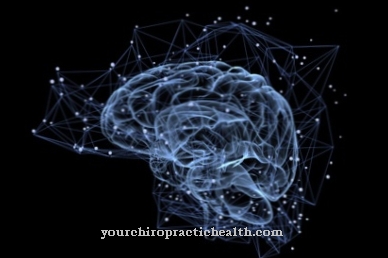The endocrinology deals with the hormonal processes and their disorders in the organism. For this reason, it has many points of contact with other medical disciplines. For the diagnosis of endocrine diseases, in addition to the classic examination methods, a large number of endocrinological function tests are available.
What is Endocrinology?

Endocrinology is a medical discipline that deals with the research, examination and diagnosis of hormone-related processes and diseases. In the body there are a multitude of endocrine glands and cells that produce structurally and functionally different hormones. Hormones are active ingredients that control important life processes in the body even in very low concentrations.
These are often processes that are subject to a regulating mechanism and only function optimally through the complex interaction of several hormones. Endocrinology is closely related to many other medical fields. It is initially a branch of internal medicine. There she has close ties to diabetology. Adjacent medical areas are urology, gynecology and pediatrics. It is also of great importance for surgery and nuclear medicine.
In addition, endocrinology also has many points of contact with intensive care medicine, neurology or psychiatry. Endocrine processes are closely linked to all other biological processes. Endocrinology includes the sub-areas of neuroendocrinology, diabetology, reproductive endocrinology and pediatric endocrinology.
Treatments & therapies
The spectrum of treatment for endocrine diseases includes many different diseases, which primarily have hormonal causes. These diseases include diabetes mellitus, thyroid dysfunction, hormonal high blood pressure, disorders of the fluid and electrolyte balance, disorders of the bone metabolism, disorders of the adrenal glands, regulatory disorders of the sexual function, growth disorders, disorders of the energy metabolism or disorders of the neuroendocrine system.
Diabetes mellitus is caused by an absolute or relative deficiency of the hormone insulin. Insulin is a protein hormone that regulates blood sugar levels. The complications of diabetes mellitus extend far into the spectrum of internal diseases. Therefore, the example of diabetology already shows what immense importance endocrinology has for other areas of medicine. In the event of malfunctions or even failure of the pituitary gland, several hormones and thus regulatory and control processes in the body are affected. The pituitary gland synthesizes both hormones that act directly on the organs and hormones that regulate other hormones.
This is where the growth hormone is formed, which acts directly on the organs by stimulating growth. A deficiency in this hormone can lead to short stature, for example. Hormones are also produced there that stimulate the gonads, the thyroid gland or the adrenal cortex. These three organs are in turn endocrine glands. Your hormone production is stimulated by certain hormones from the anterior pituitary gland. The most important superordinate organ of hormone regulation is the hypothalamus. At the same time it is the supreme control center of the autonomic nervous system. Thus, the hypothalamus coordinates the cooperation of the vegetative nervous system with the hormonal system.
The diseases of the neuroendocrine system have their starting point there. This is what the vast field of neuroendocrinology deals with. Diseases of the adrenal gland, in turn, can lead to various syndromes such as Cushing's, Addison's or Conn's syndrome. Furthermore, the electrolyte metabolism is often disturbed. Diseases such as osteoporosis or rickets are also at least partially due to hormones. Hormonal disorders can be both primary and secondary.
In the case of the primary hormonal disorder, the cause of the disease is either an under- or over-function of the corresponding endocrine gland. In secondary endocrine diseases, another disease is underlying that triggers the hormonal disorder.This can be caused by infections or autoimmune diseases.
Diagnosis & examination methods
The diagnosis of endocrine diseases can be very difficult due to their often unspecific symptoms. Sometimes the actual endocrinology only comes into play after long investigations. Within endocrinology, all classic examination methods are initially used. At the beginning there is always the anamnesis of the medical history. Sometimes a suspicion of a hormone-related disease can already be expressed here.
Laboratory tests for determining hormones in blood, serum or plasma play an important role. In addition, of course, conventional blood tests must also be carried out. A hormone test is also carried out in the urine. Dynamic and static endocrinological function tests are of great importance. In the dynamic function tests, the transition behavior within the control loop is examined by adding interfering substances. The static function tests are carried out without test substances. This works by measuring various parameters in a state of equilibrium, whereby the quotients between hormones and substrates are calculated.
Based on these calculated quotients, it can be concluded that there is a malfunction in the control mechanism. With the SPINA method, structural parameters of endocrine control loops are calculated from measured hormone levels. HOMA is, in turn, a special method for calculating the control loop for carbohydrate homeostasis. Insulin sensitivity and beta cell function can be calculated using the insulin and glucose levels in the fasted state. In addition to these examination methods, direct organ examinations of endocrine organs are of course also carried out in endocrinology. This is done through their puncture and cytological examination.
Ultrasound scans can be used to perform thyroid, parathyroid, and adrenal ultrasonography. Other imaging methods for displaying endocrine organs are X-ray diagnostics, computer tomography, magnetic resonance tomography, scintigraphy or PET examinations (positron emission tomography). In both scintigraphy and PET, radioactively marked substances are used to determine tumor cells in various organs. Often, tumors within endocrine organs are the starting point for hormonal disorders.






.jpg)


















.jpg)

.jpg)
